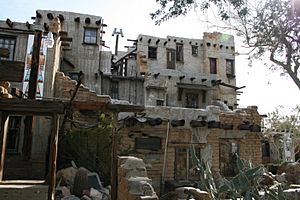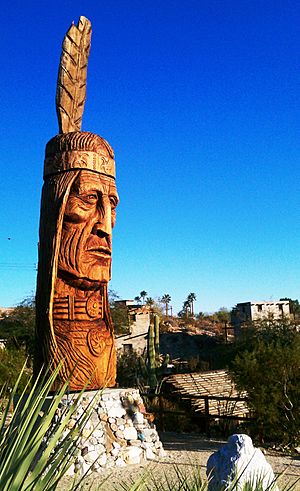Cabot's Pueblo Museum facts for kids

Pueblo Museum – Main Building
|
|
| Established | 1945 |
|---|---|
| Location | 67-616 East Desert View Ave. Desert Hot Springs, California 33°57′29″N 116°28′56″W / 33.95806°N 116.48222°W |
| Type | Historic house museum |
| Visitors | 10,000+ per year (2009) |
| Public transit access | SunLine Transit Agency Line 14 |
Cabot's Pueblo Museum is a special museum in Desert Hot Springs, California. It was built by a brave early explorer named Cabot Yerxa. This unique building looks like a traditional Hopi Indian village, called a pueblo. Inside, you can find amazing art, old tools and items from American Indian and Alaska Native cultures. It also shows what life was like for early settlers in the desert. People sometimes call it Cabot's Old Indian Pueblo Museum or Cabot's Trading Post.
Contents
Who Was Cabot Yerxa?
The museum and its buildings were created by Cabot Abram Yerxa (1883–1965). He was an early settler in the Coachella Valley in the 1900s. The museum is officially known as "Cabot’s Old Indian Pueblo Museum." The California State Parks Office of Historic Preservation also calls it "Yerxa's Discovery."
A Pioneer's Story
Cabot Yerxa was an adventurous person. He first settled on 160 acres of land in Southern California's Coachella Valley in 1913. He built his home, which he called The Eagle's Nest, on a hill. He later named this hill Miracle Hill.
Discovering Water
Using only a pick and shovel, Yerxa dug wells and found two different underground water sources. These water sources were on opposite sides of the hill. They were separated by the Mission Creek Fault, which is part of the famous San Andreas Fault.
One water source was a natural hot spring. Its water was 110 °F (43 °C) hot! This hot spring later helped the area become known for its spas and resorts. The other water source was a cold spring. This cold water still provides fresh drinking water to the city of Desert Hot Springs today. It has even won awards for its great taste!
Building the Museum
In 1917, Yerxa left the desert to join the Army during World War I. He returned to the desert in 1937. In 1939, he started building the museum to hold his collection of Native American and other items. He designed the building to look like a Hopi Indian pueblo. He did this to honor the Native American people.
Cabot's Old Indian Pueblo opened in 1950. Cabot and his wife, Portia, ran it together until he passed away in 1965. After his death, Portia moved back to Texas, and the museum was left empty.
Saving the Pueblo
Cabot Yerxa's friend, Cole Eyraud, helped protect the museum after it was abandoned. Eyraud and his family bought the complex. They worked hard to fix it up and later gave it to the City of Desert Hot Springs.
Museum Design
The main part of the museum is a large building designed like a Hopi Indian pueblo. This style is called Pueblo Revival Style. The main building is four stories tall and has 5,000 square feet (465 sq.m) of space. It has 35 rooms, 150 windows, 65 doors, and 30 different roof levels!
Cabot Yerxa built the pueblo and all the other buildings using mostly scrap wood and metal. He found these materials all over the desert. The building also has a special system of vents and shafts in its walls. These help keep it cool during the hot desert summers.
What You Can See
Collections Inside
The museum has many interesting collections, including:
- Items from American Indian and Alaska Native cultures, like Native American pottery.
- Art created by Cabot Yerxa himself.
- Old documents, photos, and letters from Cabot Yerxa.
The Waokiye Sculpture
A special addition to the museum grounds is the Waokiye sculpture. Waokiye means "traditional helper" in the Lakota language. This giant sculpture is one of 74 Native American heads carved by artist Peter Wolf Toth. His collection is called the Trail of the Whispering Giants.
The Waokiye sculpture is 43 feet tall. It was carved from a huge 45-ton (46 metric ton) giant sequoia log. This tree was 750 years old and had fallen due to lightning in the 1950s. Only the feather in Waokiye's headband was carved from a different tree. That feather came from an incense cedar tree. The statue was first shown on May 20, 1978. Peter Wolf Toth repaired it and rededicated it on February 21, 2009. It is the only one of these sculptures left in California.
How the Museum Works
Who Runs It?
The City of Desert Hot Springs owns the museum. It is managed by the Cabot's Museum Foundation. This is a non-profit group that helps run the museum. The foundation is also a member of the American Alliance of Museums.
Cabot’s Trading Post & Gallery
In 2008, the Museum Foundation opened "Cabot's Trading Post & Gallery." This space shows off artwork made by local artists.
Where to Find It
The museum is located at 67-616 East Desert View Avenue. It's in Desert Hot Springs, California, which is a spa town north of Palm Springs, California. You can get there using Line 14 of the SunLine Transit Agency from Palm Springs.
Solar Power
The museum gets its electricity from 24 solar panels. These panels are on a nearby hillside.
Future Plans
The museum has plans to make visiting even better. They want to add an amphitheater, hiking trails, and a cultural campus.
Protecting Old Items
In 2009, many old items from the pueblo were moved to a safe, secret place. In 2010, experts studied the museum. They suggested making improvements to the air filters, lighting, and how the landscape is watered. This helps protect the valuable artifacts.


